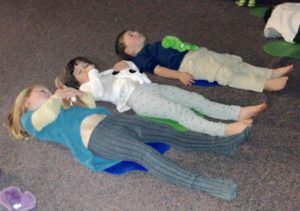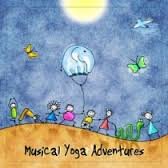The rhythmic, mesmerizing, dynamic, playful and soothing qualities of music, are a natural partner to the movement, games, stories and relaxation that describes children’s yoga classes at all developmental levels. Music and rhyme can elicit such joy and promote parent/child bonding. Research has shown that music is important in forming vital brain connections that are established from birth to age 3, in the development of intelligence, coordination, emotional expression, creativity and socialization skills.
The Benefits of Music in Child Development
1.Social-Emotional Skills
- Learn and Practice Self-Regulation: for example, when adults sooth their babies or help their toddlers calm down, these children are learning to sooth themselves.
- Understand Emotions: singing about feelings helps babies and toddlers learn to describe their emotions
- Cooperate and Build Relationships
- Experience Self-Esteem, Self-Confidence: Babies and young children become confident when they have an impact on the world around them
- Share and Take Turns
- Develop Cultural Awareness
2. Physical (motor) Skills
- Gross Motor Development
- Fine Motor Development: supported by finger rhymes and interactive songs
- Balance
- Body Awareness

- Bilateral Coordination and Crossing the Midline: Crossing the midline, when a child uses one part of the body in the space of the other, as in crawling. This requires good bilateral communication, and is necessary for the brain to be ready to read and write.
3. Thinking (Cognitive) Skills
- Counting: the rhythm and repetition of songs may make it easier for children to remember the name and sequence of number patterns*
- Patterns and Sequencing
4. Steady Beat
- Research has shown that being able to keep a steady beat is important in language development. This activates the vestibular system (part of the ear related to balance and movement), which is important for learning to take place (Hannaford, 1995).

5. Memory
Music holds a powerful place in our memory. By engaging babies as young as 8 months,they have shown recognition of a familiar piece of music after a two-week delay (Ilari & Polka 2006). If you provide your baby or toddler with consistent experiences with the same song, it will help them remember and associate the music with that experience. For instance, the same soothing lullaby at nap time, or the “pick up” song at the end of play time.
6. Pretend Play and Symbolic Thinking
Here I would like to mention the importance of involving more than one sense in an activity, as the more senses involved, the higher the success of learning the lesson. In a yoga class for toddlers, I may play a marching song, have the children swing soft scarves in both hands while I blow bubbles. They are hearing, touching (hands, feet, bubbles on their bodies), perhaps smelling, seeing.
7. Language and Literacy Skills
When the body moves, the brain produces a neuro-chemical called endorphins, which produces a feeling of energy and makes the brain more conducive to learning! Engaging the whole brain with multi-sensory input, by moving to music, helps babies retain new information. Music and movement stimulate the frontal lobes of the brain, important in language development.
- Spoken Language
- Receptive Language
- Dual Language Learning
- Phonemic Awareness
Children of all ages express themselves through music. Let’s look at each developmental stage, the role that music plays, and how music may be used in a yoga class for each age group. I will also include examples of playlists I use in my yoga classes.
- Infants try to move to music as soon as they are physically able. Singing holds babies attention better than speech alone. They recognize melodies and sway and move their hands to the music they hear. The effect of music and movement during infancy is beautifully described by Rebecca Parlakian and Claire Lerner:
“Rocking a baby stimulates early language development, promotes attachment, and supports an infant’s growing spatial awareness as the child experiences her body moving in space.”
Music for Infants
Quiet, calm background music at sleep time.
Simple, short songs in a sing-song expressive voice. Make up songs as you go about your day, caring for your infant, about bathing, dressing, eating. This sing-song-speak tends to slow us down, and we communicate that pace to our infants.
Use finger play and singing, which is fun and stimulates language development.
Music for Savasana for All Ages
One of the many benefits of music is that it imparts calm. At the end of a parent/infant yoga class it is wonderful to give these duos a few quiet moments to rest together. My favorite music, like a lullaby, for this parent child savasana is Magnificence, by Daphne Tse.
Santorini Splendor by Dan Gibson is a beautiful instrumental along the sea that I use for savasana for all ages. One of my favorite piano pieces is River Flows In You by Yiruma.
For my preschoolers and elementary school kiddos, they love to imagine, so I often play How to Be a Cloud by Kira Wiley, Ordinary Miracle by Sarah McLachlan
- Toddlers love to dance and move to music. My toddler classes are filled with short songs to accompany every action, including marches, chants, drumming, and rhymes. Songs and chants are a great way to bring awareness to the breath, as toddlers begin to be aware of breath control. Toddlers love to sing and chant in a group, starting to create social skills/feelings of connectedness. Toddlers are amazing little beings, and sharing yoga with them is full of joy and wonder.
Music I use for Toddler and Preschool Yoga Classes
I Grow with Yoga – Yoga Songs for Children, Sammie Haynes and Lisa Flynn/Childlight Yoga
 Dance for the Sun – Yoga Songs for Kids, Kira Willey
Dance for the Sun – Yoga Songs for Kids, Kira Willey
Kings and Queens of the Forest, Kira Wiley
Victor Vito, Laurie Berkner
Musical Yoga Adventures, Linda Lara
- Preschoolers love stories, music and singing. I will often read a simple, familiar story with vibrant pictures to my preschool yoginis, then use movement and music with the children to recreate the story.
A favorite; after reading Elmer, by David McKee, we stride through the jungle singing “hello” to all the animals, to Colors by Kira Wiley, then practice lion breath To The Lion Sleeps Tonight by DJs Choice, and parade around to Sina Makosa by Cool James, CD Putumayo Presents African Beat. Another favorite activity, that supports all the developmental benefits of music and movement, is shaking rice-filled wooden eggs to I Know a Chicken by Laurie Berkner. I often incorporate this activity into a story about a farm or spring, or just bring it out for fun. We parade with our eggs, walk with partners, and shake them like crazy!
- Kindergarten and School Age children carry on the continuum of the benefits and joy of movement and music. The songs I use are catchy, inspirational, and meet the energy of the yoga class. To get the wiggles out, I will often start the class with Shake Your Body Down by Laurie Berkner. Yoga poses, creative movement and games may be accompanied by music from the CD Pop Fly by Justin Roberts, Finding Nemo:Ocean Favorites by the Blue Sea Band or Ladybug Music Red Collection. The older elementary kiddos love songs from the CD Songs for a Healthier America, that have a hip-hop beat, and contain a message about healthier bodies, minds, and environment.

- Preteens enjoy practicing yoga sequences, partner poses and connecting activities to playlists that include popular music. Some of my playlists for this age group include:
Let It Go by Birdy and Rhodes
I Am What I Am by Aykanna
One Day by Matsiyahu
Wings by Niklas Aman
Breathe by Taylor Swift
All My Loves Laughter by Art Garfunkel
Torey’s Distraction, The Album Leaf
True Love, A Sky Full of Stars, Midnight by Coldplay, (and many other of their songs)
Wait by M83
Happy by Pharrell Williams
Beautiful by Christina Aguilera (I use this in a Power Girls Yoga Class)
Where the Streets Have No Name by 2 Cellos (for Savasana)
Music is a wonderful mind weaver, and we have many opportunities in the early years to help orchestrate and harmonize the brains of our children with quality experience.
__Don Campbell
References:
“How Music Benefits Children” – Parenthood.com
www.parenthood.com/article/how_music_benefits_children.html
“Children and Music: Benefits of Music in Child Development” | Bright …
www.brighthorizons.com/…/2010-musi…
“Beyond Twinkle, Twinkle: Using Music with Infants and Toddlers” 2010 …
eric.ed.gov/?id=EJ898687
by R Parlakian – 2010 –
Leave a Reply